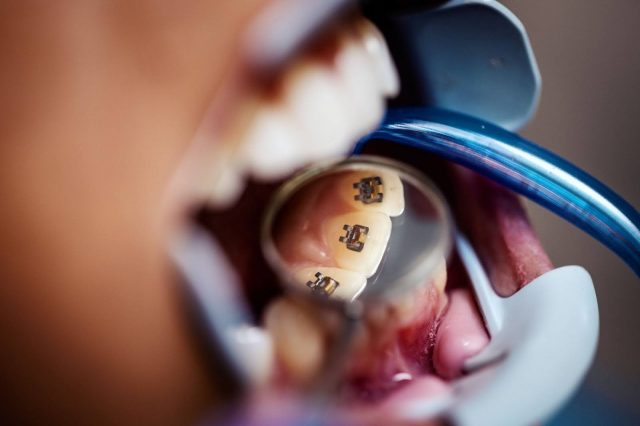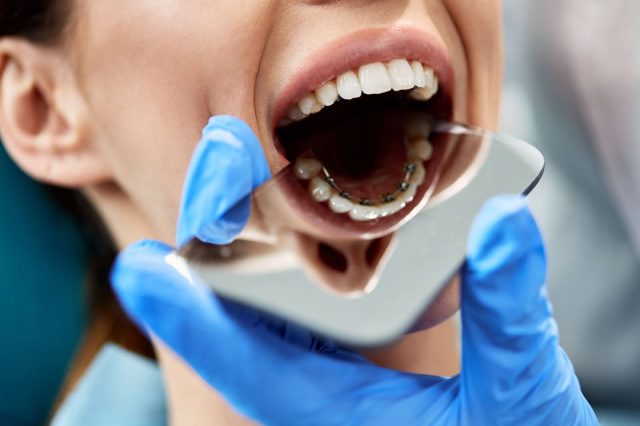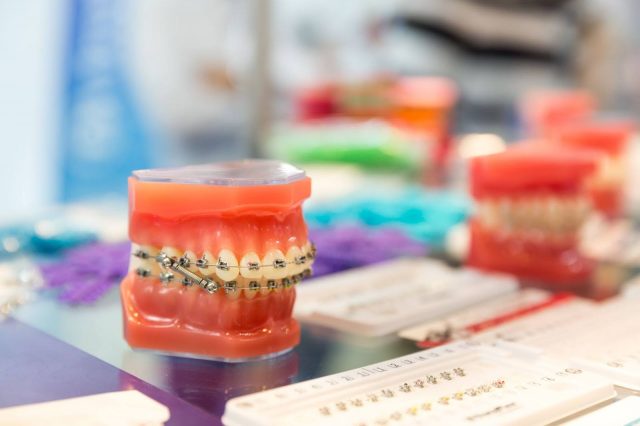As orthodontic care further advances, its popularity increases. In Singapore, more people are prioritising their oral health. And of course, its aesthetics.
Lingual braces, a discreet and effective orthodontic option, are garnering attention. Especially among those seeking to straighten their teeth without compromising their appearance.
This detailed guide will provide you with all the essential information about lingual braces. Including, their benefits, potential drawbacks, costs in Singapore, and tips for maintenance.
By the end of this blog, you will have a clear understanding of whether lingual braces are the right choice for you.
What Are Lingual Braces?
Like other braces, lingual braces are an orthodontic treatment designed to straighten teeth. The best part however is that they remain virtually invisible.
Unlike traditional braces, lingual braces are bonded to the inner side (lingual surface) of the teeth. This makes them hidden from view.
Hence, this feature makes them very appealing to adults and teens who prefer a discreet treatment option.
These braces are fully customised for each individual. Advanced imaging technology is used to design brackets and wires that fit the unique shape of your teeth. This ensures optimal comfort and effectiveness.
(Source: Envato Elements)
Lingual Braces: How Do They Work?
The function of lingual braces is similar to traditional braces. They apply continuous, gentle pressure to move teeth into their correct positions.
The key difference lies in their placement, which is behind the teeth. This requires specialised equipment and expertise.
In general, this is the process involved in getting lingual braces:
1. Consultation and Assessment
An orthodontist evaluates your dental condition and determines whether lingual braces suit your needs.
2. Customisation
Moulds or 3D scans of your teeth are taken to create brackets tailored to your teeth.
3. Fitting
The customised brackets are bonded to the back of your teeth. Wires are then attached to guide the teeth into alignment.
4. Regular Adjustments
Periodic visits are required to adjust the wires and ensure the braces are working effectively.
(Source: Envato Elements)
Advantages of Lingual Braces
1. Discreet Appearance
One of the most significant benefits of lingual braces is their near invisibility. Since they are attached to the back of your teeth, they remain hidden from view. Be it during conversations, meetings, or photographs. This makes them very appealing to:
- Professionals in corporate roles who need to maintain a polished appearance.
- Teens and young adults who feel self-conscious about visible braces.
- Public-facing individuals. Such as actors, models, and presenters, who prioritise aesthetics during treatment.
For patients in Singapore, appearances often play a key role in professional and social settings. Hence, the discreet nature of lingual braces offers unmatched confidence throughout the treatment journey.
2. Customised Comfort
Lingual braces are individually tailored to fit the unique shape of your teeth. Advanced imaging and design technologies are used to create brackets and wires that contour perfectly to your dental structure. This customisation:
- Minimises irritation to the inner surfaces of your teeth.
- Enhances treatment efficiency by targeting specific areas with precision.
- Reduces the likelihood of adjustments needing frequent corrections.
While initial discomfort is common, this personalised fit ensures that long-term comfort is optimised. Thus, making lingual braces a comfortable option for most patients.
3. Effective for Complex Cases
Lingual braces are very versatile and capable of addressing a wide range of orthodontic issues. These includes:
- Severe overcrowding.
- Misaligned bites (crossbites, underbites, and mild overbites).
- Large gaps between teeth.
Lingual braces provide the robust correction needed for challenging dental problems. Unlike clear aligners, which may not be suitable for more complex cases.
The ability of lingual braces to apply precise and continuous pressure makes them a dependable solution for achieving excellent results. Even in complicated cases.
4. Durable and Reliable
Similar to traditional braces, lingual braces are made from high-quality materials. These materials are designed to withstand the forces of chewing and biting.
They deliver predictable and long-lasting results. Hence, ensuring that your smile remains straight and healthy well beyond the treatment period.
Patients looking for a treatment that combines durability with discretion will find lingual braces to be a reliable choice.
(Source: Envato Elements)
Disadvantages of Lingual Braces
1. Higher Cost
Lingual braces are more expensive than traditional metal braces or clear aligners. This is due to:
- The customisation process for creating individualised brackets.
- The advanced expertise and training required for orthodontists to fit and adjust these braces.
In Singapore, the cost of lingual braces ranges from SGD 8,000 to SGD 15,000. This depends on the complexity of the case and the orthodontist’s expertise among other factors.
For those with budget constraints, it is best to explore payment plans offered by orthodontic clinics. This may make the treatment more affordable.
Many clinics in Singapore provide instalment payment plans. Thus, making the treatment more affordable for patients.
2. Initial Discomfort
The placement of lingual braces on the inner surface of the teeth can cause initial discomfort. Particularly, for the tongue. This discomfort may include:
- Irritation or soreness as the tongue frequently comes into contact with the brackets.
- Speech difficulties, such as a temporary lisp.
Most patients adapt within a few weeks, and the discomfort can be managed with:
- Orthodontic wax to cover sharp edges.
- Soft foods during the adjustment period.
- Pain relievers for initial soreness.
While the adjustment phase requires patience, these challenges are temporary. They tend to subside as your mouth gets used to the braces.
(Source: Envato Elements)
3. Challenging Maintenance
Maintaining oral hygiene with lingual braces is more demanding than with other orthodontic treatments. Their position on the back of the teeth makes cleaning difficult. This increases the risk of:
- Food particles becoming trapped.
- Plaque and tartar buildup.
- Potential cavities or gum issues if proper care is not taken.
To overcome these challenges, patients are encouraged to
- Use specialised tools. Such as interdental brushes and floss threaders.
- Brush thoroughly after every meal. Focus on the back surfaces of the teeth.
- Use an antibacterial mouthwash to minimise plaque and bacteria.
Regular dental check-ups and professional cleanings are essential. This is to ensure that the braces maintain optimal oral health. We will look further into this in the next section.
4. Not Suitable for Everyone
Lingual braces are not universally suitable. Factors that may limit their applicability include:
- Small Teeth
Patients with small teeth may not have enough surface area for the brackets to adhere securely.
- Severe Overbites
Lingual braces may not be ideal for individuals with pronounced overbites. In such cases, the lower teeth can often contact the brackets on the upper teeth. This causes discomfort or damage to the braces.
- Specific Jaw Conditions
Certain bite issues or jaw misalignments may require alternative orthodontic treatments.
Hence, a thorough assessment by an experienced orthodontist is critical. This is to determine whether lingual braces are the right fit for your dental structure and treatment goals.
Balancing the Pros and Cons of Lingual Braces
Lingual braces are a remarkable orthodontic advancement that offer discreet treatment and reliable results.
While they require a higher investment and greater care, their aesthetic appeal and effectiveness make them a preferred option for many patients.
By understanding both the benefits and challenges, you can make an informed decision about whether lingual braces align with your lifestyle and orthodontic needs.
(Source: Envato Elements)
Maintaining Oral Hygiene with Lingual Braces
It is important to maintain excellent oral hygiene with lingual braces. This is to ensure the success of your treatment and prevent complications such as cavities or gum disease.
Here are some practical tips for cleaning and caring for your lingual braces:
- Brush Thoroughly
Clean every surface of your teeth using a toothbrush with soft bristles. Pay special attention to the inner surfaces where the braces are attached.
These small brushes are ideal for cleaning around the brackets and wires.
- Floss Often
Use floss threaders or orthodontic-specific floss to clean between teeth.
- Rinse with Mouthwash
Antibacterial mouthwash can help prevent plaque buildup and keep your gums healthy.
- Avoid Certain Foods
Sticky, chewy, or hard foods can damage the braces or become trapped. This increases the risk of cavities.
Lingual Braces vs Other Orthodontic Options
When choosing an orthodontic treatment, it is essential to compare the pros and cons of different options.
Here is how lingual braces stack up against other popular choices:
| Treatment Option | Visibility | Comfort | Effectiveness | Cost |
| Lingual Braces | Invisible | Moderate discomfort | High | Higher cost |
| Metal Braces | Visible | Moderate discomfort | High | Lower cost |
| Clear Aligners | Nearly invisible | High comfort | Moderate for complex cases | Higher cost |
Contact us to explore other orthodontic options. We customise our treatments to suit your unique dental requirements.
(Source: Envato Elements)
Are Lingual Braces Right for You?
Lingual braces are a specialised orthodontic solution that caters to individuals seeking a discreet treatment option. However, their suitability is not universal and depends on various factors.
Below is a breakdown of key considerations to help you decide if lingual braces are the right choice for you:
1. Your Orthodontic Needs
Lingual braces are highly effective for addressing a range of orthodontic issues, including:
- Mild to moderate crowding.
- Gaps between teeth.
- Crooked or misaligned teeth.
- Bite correction (in select cases).
Your orthodontist will evaluate the alignment of your teeth and bite to determine if lingual braces are a suitable option for you.
2. Your Budget
Lingual braces are a premium orthodontic treatment. They often cost more than traditional braces.
If your budget is a concern, you may wish to explore alternative options. Such as ceramic braces or clear aligners.
However, many clinics offer flexible payment plans to make lingual braces more accessible. Discuss financing options with your orthodontist to see if this treatment aligns with your financial plans.
3. Aesthetic Priorities
Lingual braces are perfect for individuals who want their orthodontic treatment to remain virtually invisible.
If maintaining a natural appearance during treatment is a priority for you, lingual braces offer an unparalleled level of discretion.
4. Lifestyle and Commitment to Care
Lingual braces require diligent oral hygiene practices. This is due to their placement behind the teeth. Food debris and plaque can build up in hard-to-reach spots. Hence, making cleaning more challenging.
If you are willing to dedicate time to maintaining proper oral hygiene and attending regular orthodontic check-ups, lingual braces could work well for you.
However, if you find oral hygiene difficult to manage, other options like clear aligners, may be more practical. This is because they are removable and easy to clean.
(Source: Envato Elements)
5. Comfort and Adaptation
Lingual braces can cause initial discomfort, especially for the tongue, as it comes into contact with the brackets.
Speech difficulties, such as a slight lisp, may also arise but typically resolve as you adjust.
If you are someone who is sensitive to oral discomfort or requires minimal disruption to your speech, consider whether you can accommodate the adjustment period. Your orthodontist may provide tips or wax to reduce irritation during this phase.
6. Severity of Overbite or Small Teeth
Patients with severe overbites or very small teeth may not be ideal candidates for lingual braces.
In the case of a pronounced overbite, the brackets on the back of the upper teeth are more likely to come into contact with the lower teeth. This will cause complications.
Similarly, small teeth may not provide enough surface area for secure bracket placement.
In such cases, your orthodontist may recommend alternative treatments. Such as, traditional braces or clear aligners, which do not pose these challenges.
Addressing Common Concerns Related to Lingual Braces
Lingual braces offer many benefits, but like any orthodontic treatment, they come with questions and potential challenges.
Below, we address some of the most common concerns to help you better understand what to expect during your lingual braces journey.
1. Do Lingual Braces Hurt?
As with any orthodontic treatment, discomfort is common when lingual braces are first fitted or after adjustments.
This discomfort is caused by the pressure exerted by the braces to move your teeth into their correct positions.
Unlike traditional braces, the placement of lingual braces on the inner side of your teeth can also irritate the tongue initially and cause ulceration to the tongue or surrounding soft tissues.
However, this discomfort subsides after a few weeks as your mouth adapts to the new hardware. You can take the following steps to manage the initial soreness:
- Orthodontic Wax
Applying wax to the brackets can reduce irritation and create a smoother surface for your tongue.
- Over-the-Counter Pain Relief
Medications such as ibuprofen or paracetamol can help alleviate any pain or discomfort during the adjustment period.
- Soft Foods
Opt for softer foods like soups, mashed potatoes, or yoghurt during the first few days to avoid putting excessive pressure on your teeth.
Rest assured, your orthodontist will guide you on managing any discomfort and provide solutions to minimise irritation.
(Source: Envato Elements)
2. Will They Affect My Speech?
Lingual braces can initially impact your speech. They cause minor changes such as a slight lisp.
This happens because the brackets are placed on the back of your teeth, an area that directly interacts with your tongue during speech.
Words that involve the tongue touching the teeth, such as those with “s” or “th” sounds, may feel challenging at first.
The good news is that these speech issues are temporary. Most patients adjust within two to three weeks as their tongue adapts to the new environment.
Here are some tips to speed up the adjustment process:
- Practice Speaking
Regularly practising your speech can help you adapt quickly. Try reading aloud or reciting phrases that include challenging sounds.
- Slow Down Your Speech
Speaking slowly and clearly can help your tongue adjust to the braces. Over time, your speech will return to normal.
- Stay Hydrated
Keeping your mouth hydrated can make it easier for your tongue to move smoothly over the brackets.
If speech difficulties persist beyond the adjustment period, your orthodontist can provide recommendations to address the issue.
3. How Long Does Treatment Take?
The duration of treatment with lingual braces depends on the complexity of your case. It also relies on your orthodontic goals.
On average, patients wear lingual braces for 18 to 36 months. However, the timeline can vary based on factors such as:
- Severity of the Orthodontic Issue
Simple cases, such as mild crowding or gaps, may be resolved in less time. Complex issues, such as bite correction or severe misalignment, may require a longer treatment period.
- Patient Compliance
Attending regular orthodontic appointments for adjustments and maintaining good oral hygiene can influence the effectiveness and duration of treatment.
- Age
Adults may have slightly longer treatment times compared to teenagers, as adult bones are more rigid and less responsive to orthodontic forces.
During your initial consultation, your orthodontist will provide an estimated treatment timeline based on your specific needs. Regular check-ups and adjustments are critical to ensuring your treatment progresses as planned.
Additional Tips to Ease Concerns
- Be Patient with the Process
While it may take time to adjust to lingual braces, the results are worth the effort. Lingual braces offer the advantage of discretion while delivering reliable and lasting results.
- Communicate with Your Orthodontist
If you experience prolonged discomfort, persistent speech issues, or other concerns, do not hesitate to reach out to your orthodontist. They can provide personalised solutions to address any challenges.
(Source: Envato Elements)
Final Thoughts on Lingual Braces
Lingual braces are an excellent orthodontic option for those who value discretion and effectiveness. While they come with certain challenges, their benefits make them a worthwhile investment for achieving a perfect smile.
In Singapore, skilled orthodontists and flexible payment plans make exploring lingual braces more accessible than ever. If you are considering this treatment, book a consultation with a qualified orthodontist. They can provide personalised advice and help you achieve your goals.
A straighter, more confident smile is just a treatment away.
For more insights into orthodontic treatments, tips, and FAQs, explore our website on thebracespractice.com. If you have any questions, feel free to contact us. We are always happy to help!
















